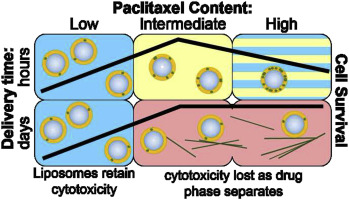当前位置:
X-MOL 学术
›
Biomaterials
›
论文详情
Our official English website, www.x-mol.net, welcomes your
feedback! (Note: you will need to create a separate account there.)
Distinct solubility and cytotoxicity regimes of paclitaxel-loaded cationic liposomes at low and high drug content revealed by kinetic phase behavior and cancer cell viability studies
Biomaterials ( IF 12.8 ) Pub Date : 2017-08-17 , DOI: 10.1016/j.biomaterials.2017.08.026 Victoria M Steffes 1 , Meena M Murali 2 , Yoonsang Park 2 , Bretton J Fletcher 2 , Kai K Ewert 2 , Cyrus R Safinya 3
Biomaterials ( IF 12.8 ) Pub Date : 2017-08-17 , DOI: 10.1016/j.biomaterials.2017.08.026 Victoria M Steffes 1 , Meena M Murali 2 , Yoonsang Park 2 , Bretton J Fletcher 2 , Kai K Ewert 2 , Cyrus R Safinya 3
Affiliation

|
Lipid-based particles are used worldwide in clinical trials as carriers of hydrophobic paclitaxel (PTXL) for cancer chemotherapy, albeit with little improvement over the standard-of-care. Improving efficacy requires an understanding of intramembrane interactions between PTXL and lipids to enhance PTXL solubilization and suppress PTXL phase separation into crystals. We studied the solubility of PTXL in cationic liposomes (CLs) composed of positively charged 2,3-dioleyloxypropyltrimethylammonium chloride (DOTAP) and neutral 1,2-dioleoyl-sn-glycero-3-phosphatidylcholine (DOPC) as a function of PTXL membrane content and its relation to efficacy. Time-dependent kinetic phase diagrams were generated from observations of PTXL crystal formation by differential-interference-contrast microscopy. Furthermore, a new synchrotron small-angle x-ray scattering in situ methodology applied to DOTAP/DOPC/PTXL membranes condensed with DNA enabled us to detect the incorporation and time-dependent depletion of PTXL from membranes by measurements of variations in the membrane interlayer and DNA interaxial spacings. Our results revealed three regimes with distinct time scales for PTXL membrane solubility: hours for >3 mol% PTXL (low), days for ≈ 3 mol% PTXL (moderate), and ≥20 days for < 3 mol% PTXL (long-term). Cell viability experiments on human cancer cell lines using CLPTXL nanoparticles (NPs) in the distinct CLPTXL solubility regimes reveal an unexpected dependence of efficacy on PTXL content in NPs. Remarkably, formulations with lower PTXL content and thus higher stability show higher efficacy than those formulated at the membrane solubility limit of ≈3 mol% PTXL (which has been the focus of most previous physicochemical studies and clinical trials of PTXL-loaded CLs). Furthermore, an additional high-efficacy regime is seen on occasion for liposome compositions with PTXL ≥9 mol% applied to cells at short time scales (hours) after formation. At longer time scales (days), CLPTXL NPs with ≥3 mol% PTXL lose efficacy while formulations with 1–2 mol% PTXL maintain high efficacy. Our findings underscore the importance of understanding the relationship of the kinetic phase behavior and physicochemical properties of CLPTXL NPs to efficacy.
中文翻译:

动力学相行为和癌细胞活力研究揭示了负载紫杉醇的阳离子脂质体在低和高药物含量下的不同溶解度和细胞毒性机制
脂质颗粒在全球临床试验中用作疏水性紫杉醇 (PTXL) 的载体用于癌症化疗,尽管与护理标准相比几乎没有改善。提高功效需要了解 PTXL 和脂质之间的膜内相互作用,以增强 PTXL 溶解并抑制 PTXL 相分离成晶体。我们研究了 PTXL 在由带正电荷的 2,3-二油酰氧基丙基三甲基氯化铵 (DOTAP) 和中性 1,2-二油酰-sn-甘油-3-磷脂酰胆碱 (DOPC ) 组成的阳离子脂质体 (CL) 中的溶解度,作为 PTXL 膜含量的函数及其与功效的关系。通过微分干涉对比显微镜观察 PTXL 晶体形成,生成时间依赖性动力学相图。此外,一种新的同步加速器小角度 X 射线原位散射方法应用于凝聚有 DNA 的 DOTAP/DOPC/PTXL 膜,使我们能够通过测量膜夹层的变化来检测 PTXL 从膜中的掺入和时间依赖性消耗,以及DNA 轴间距。我们的结果揭示了 PTXL 膜溶解度具有不同时间尺度的三种方案:>3 mol% PTXL 需要数小时(低),约 3 mol% PTXL 需要数天(中等),< 3 mol% PTXL 需要 ≥20 天(长期) )。在不同的 CL PTXL 溶解度范围内使用 CL PTXL 纳米颗粒 (NP)对人类癌细胞系进行的细胞活力实验揭示了功效对 NP 中 PTXL 含量的意外依赖性。值得注意的是,具有较低 PTXL 含量并因此具有较高稳定性的制剂比在膜溶解度极限为 约 3 mol% PTXL 时配制的制剂(这一直是大多数先前负载 PTXL 的 CL 的物理化学研究和临床试验的焦点)显示出更高的功效。此外,对于具有PTXL≥9mol%的脂质体组合物,有时会在形成后的短时间尺度(小时)内将其施加至细胞,从而看到额外的高效方案。在较长的时间尺度(天)下,含有 ≥3 mol% PTXL 的CL PTXL NP 会失去功效,而含有 1-2 mol% PTXL 的制剂则保持高功效。我们的研究结果强调了了解 CL PTXL NP 的动力学相行为和理化性质与功效之间的关系的重要性。
更新日期:2017-08-17
中文翻译:

动力学相行为和癌细胞活力研究揭示了负载紫杉醇的阳离子脂质体在低和高药物含量下的不同溶解度和细胞毒性机制
脂质颗粒在全球临床试验中用作疏水性紫杉醇 (PTXL) 的载体用于癌症化疗,尽管与护理标准相比几乎没有改善。提高功效需要了解 PTXL 和脂质之间的膜内相互作用,以增强 PTXL 溶解并抑制 PTXL 相分离成晶体。我们研究了 PTXL 在由带正电荷的 2,3-二油酰氧基丙基三甲基氯化铵 (DOTAP) 和中性 1,2-二油酰-sn-甘油-3-磷脂酰胆碱 (DOPC ) 组成的阳离子脂质体 (CL) 中的溶解度,作为 PTXL 膜含量的函数及其与功效的关系。通过微分干涉对比显微镜观察 PTXL 晶体形成,生成时间依赖性动力学相图。此外,一种新的同步加速器小角度 X 射线原位散射方法应用于凝聚有 DNA 的 DOTAP/DOPC/PTXL 膜,使我们能够通过测量膜夹层的变化来检测 PTXL 从膜中的掺入和时间依赖性消耗,以及DNA 轴间距。我们的结果揭示了 PTXL 膜溶解度具有不同时间尺度的三种方案:>3 mol% PTXL 需要数小时(低),约 3 mol% PTXL 需要数天(中等),< 3 mol% PTXL 需要 ≥20 天(长期) )。在不同的 CL PTXL 溶解度范围内使用 CL PTXL 纳米颗粒 (NP)对人类癌细胞系进行的细胞活力实验揭示了功效对 NP 中 PTXL 含量的意外依赖性。值得注意的是,具有较低 PTXL 含量并因此具有较高稳定性的制剂比在膜溶解度极限为 约 3 mol% PTXL 时配制的制剂(这一直是大多数先前负载 PTXL 的 CL 的物理化学研究和临床试验的焦点)显示出更高的功效。此外,对于具有PTXL≥9mol%的脂质体组合物,有时会在形成后的短时间尺度(小时)内将其施加至细胞,从而看到额外的高效方案。在较长的时间尺度(天)下,含有 ≥3 mol% PTXL 的CL PTXL NP 会失去功效,而含有 1-2 mol% PTXL 的制剂则保持高功效。我们的研究结果强调了了解 CL PTXL NP 的动力学相行为和理化性质与功效之间的关系的重要性。











































 京公网安备 11010802027423号
京公网安备 11010802027423号